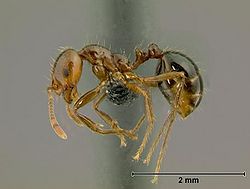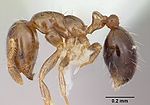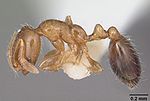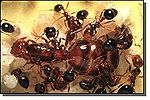Fire ant
| Fire ant |
|---|

|
| Scientific Classification |
|
| Selected Species |
|
| Solenopsis Papuana |
Fire ants are any of the species of ants that belong to the taxonomic genus Solenopsis. They are perhaps best known for their extreme aggression exhibited when provoked and venom which leaves victims with a burning sensation, hence their name [2]. They are social insects that live in colonies with three biologically distinct castes: queens, reproductive males called alates, and workers [3] [4] [5] [6] [7]. Their colonies' stability depends in part upon the division of labor present, as seen in the multiple roles within a colony and the necessity for the presence of each type of fire ant[8]. Once introduced to an area, they are very difficult to stop and almost impossible to exterminate. Various attempts at control are mixed in their effect and the fire ants will be kept at bay under the best of circumstances. More often, it is other species who flee the fire ant, and not the other way around [9]. Being able and willing to eat almost anything, as well as adapting to almost any type of environment, this invasive and widespread genus is capable of massive upsetting within ecosystems [10]. While they are not anatomically different than most other ants, having a pair of antennae, three pairs of legs, and being divided into a head, a thorax, and an abdomen [11] fire ants nonetheless are fearsome and powerfulcreatures because of their amazing reproductive abilities [12] and deadly venom [13].
Body Design
Fire ants, like most insects, have three main body segments: a head with a pair of antennae, and a thorax and an abdomen which contain three pairs of legs [14]. The three types of ants (female queens, which lay eggs and reproduce; male alates (which reproduce only); and sterile female workers which perform the various tasks necessary for the upkeep of the colony) are anatomically equipped for their functions. Despite this, and the fact that wings are present only in queens and alates, the basic anatomy of fire ants is the same [15] [16]. The head consists mainly of the mandibles to chew food, antennae which detect the surrounding area and communicate with other fire ants, as well as clusters of nerves which serve as the nervous and optic systems in lieu of a brain or eyes. The thorax consists of the legs and (on queens and male alates) wings, and is fused to the abdomen, the part of the fire ant containing the stinger and digestive system [17].
Life Cycle
Like many insect species, fire ants undergo complete metamorphosis with four stages of life: eggs, larvae, pupae, and adults. The egg stage lasts for around eight to ten days, the larval stage lasts for around six to twelve days, and the pupae stage lasts for around nine to sixteen days, thus making the time span from an egg to an adult fire ant about one month. While the colony is still developing, the first workers are quite small, but the next groups are larger as the colony grows. The larval stage has four instars (periods) in which the ants are fed liquid food for the first three periods and solid food for the last. Larvae of the last period produce substances that are then used to feed the worker ants and queen. [18]. The eggs are laid by the queen and are the result of her mating with some of the male alates, who die soon afterwards. Eggs eventually develop into queens, alates, or workers and are fed and environmentally conditioned as larvae and pupae to perform their specific roles. After hatching, workers will take on their age-appropriate tasks of grooming the queen, maintaining, cleaning, and protecting the hive, and finding food [19]. Males alates will die after mating, while female workers typically live anywhere from 30-180 days, and queens live two to six years. [20].
Fire ants are eusocial insects with a self-perpetuating mode of species survival, even at the cost of entire colonies. Each stage of life and group within the colony assists in the stability of every other stage of life, as workers keep queens alive to lay eggs, and reproductive males (alates) produce new colonies [21]. Eggs develop into one of three types of adults: female sterile workers, male alates, and female alates. While the workers perform the tasks necessary to provide for the hive at differing stages of live, the alates keep the population stable. When the colony has produced enough alates to care for its own needs, an alate will mate with the queen, the male will die, and the female will found a new colony, keeping the fire ant population strong. Mature colonies can include over 400,000 worker ants and typical colonies include 80,000 workers, with queens each laying up to 1,500 eggs per day [22] [23].
Ecology
Fire ants consume primarily the dead bodies of invertebrates, but also make use of small vertebrate bodies if they can be found and the secretions of the queen. They live in mounds of earth that can reach up to forty centimeters in height and are complete with underground chambers for the care of broods, usually in places with lower temperatures. The nests are often found under natural shelters, such as rocks, but fire ants have also been known to take over the nests of other social insects. One of the reasons for their survival abilities is the adaptation that they can have to almost any environment, including taking shelter near man-made electrical appliances. The queen will build a small shelter herself when the colony begins, but the newest workers will quickly make additions and improvements to the hastily-made emergency structure. The more stable fire ant colonies are polygyne colonies which have more than one queen to keep a safe population margin in case of disaster. Monogyne colonies which have only one queen are far less stable and are more often singled out as easy targets by other colonies. Generally speaking, the larger and more mature a fire ant colony is, the more stable and less vulnerable it will be because of the population losses that it can withstand. [24].
Effect and Control
Fire ants spread rapidly, but their effects upon humans can be downsized if a few simple practices are observed. For example, park officials can use insecticides and specially-made poisons to individually kill entire colonies. This is usually done during colder weather when the surviving ants are dormant. The poisons used do not need to be expensive as pouring three gallons of hot water has for the most part proven effective at the elimination of colonies. The four major types of fire ants (Solenopsis Invicta, Solenopsis Richteri, Solenopsis Xyloni, and Solenopsis germinata together cause more damage than any other species of fire ant [25]. One of the main reasons that fire ants are so feared and despised by many is their painful venom. The multiple bites inflicted by each individual fire ant in an onslaught is in itself painful, but the venom gives a victim a burning sensation, hence the name 'Fire Ant' [26]. As a general rule, people will move out of the fire ants' way sooner than they will exterminate a local population, due in part to the amount of time that is often necessary. Fire ants are very adaptive to different environments and can survive quite well in urban areas, so building owners in infested areas must take extra precautions to ensure that the ants will not crawl in through small openings in their walls. Any infested area will most likely not be rid of fire ants in any short amount of time, so the best option is often to simply stay educated about precautions and sting treatment [27].
Video
Video description here....
Gallery
References
- [28] Wikispecies. Web. 9 March 2009 (Published).
- [29] University of Florida Entomology and Nematology Department. Web. 4 December 2012 (Accessed).
- [30] Queensland Government Department of Agriculture, Fisheries, and Forestry. Web. 4 December 2012 (Accessed).
- [31] Smithsonian Marine Station at Fort Pierce. Web. 4 October 2007 (Published- Last Updated).
- [32] National Park Service. Web. 4 December 2012 (Accessed).
- [33] Washington State University Extension. Web. 11 April 2011 (Published).
- [34] Encyclopedia of Life. Web. 4 December 2012 (Accessed).








